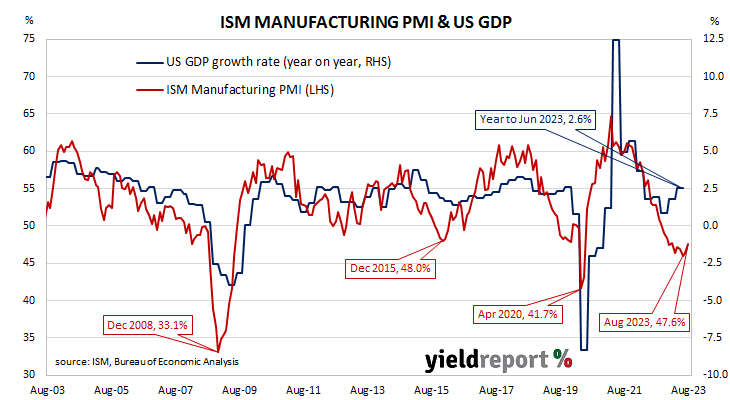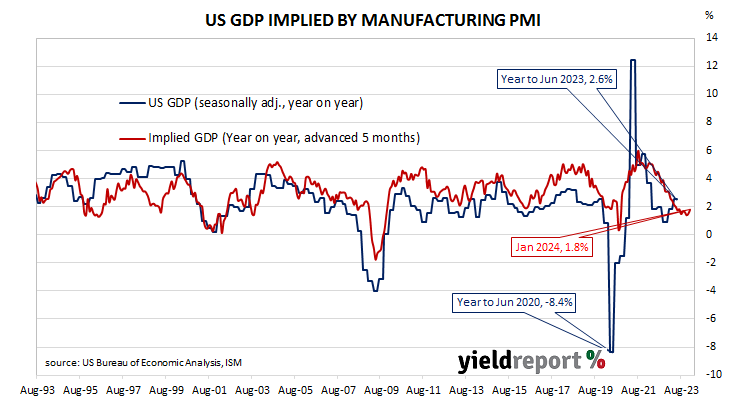Summary: ISM PMI up in August, above expectations; NAB: further increases in index, overall growth expected in months ahead; long-term US Treasury yields noticeably higher; expectations of Fed rate cuts in first half of 2024 firm; ISM: reading corresponds to 0.4% US GDP contraction annualised.
The Institute of Supply Management (ISM) manufacturing Purchasing Managers Index (PMI) reached a cyclical peak in September 2017. It then started a downtrend which ended in March 2020 with a contraction in US manufacturing which lasted until June 2020. Subsequent month’s readings implied growth had resumed, with the index becoming stronger through to March 2021. Readings have since declined fairly steadily.
According to the ISM’s August survey, its PMI recorded a reading of 47.6%, above the generally expected figure of 46.9% as well as July’s 46.4%. The average reading since 1948 is 53.0% and any reading below 50% implies a contraction in the US manufacturing sector relative to the previous month.
“While the ISM report indicates a ninth month of contraction, the index has turned higher over the past two months and, if the historical relationship between the difference between new orders and inventories holds, further increases in the headline ISM index and overall growth are expected in the months ahead,” said NAB economist Skye Masters.
The figures were released on the same day as the latest non-farm payrolls report and long-term US Treasury yields finished the day noticeably higher. By the close of business, the 2-year Treasury bond yields had inched up 1bp to 4.88%, the 10-year yield had gained 7bps to 4.18% while the 30-year yield finished 9bps higher at 4.30%.
In terms of US Fed policy, expectations of a lower federal funds rate in the first half of 2024 firmed. At the close of business, contracts implied the effective federal funds rate would average 5.335% in September, slightly above the current spot rate, and then average 5.345% in October. December futures contracts implied a 5.41% average effective federal funds rate while August 2024 contracts implied 4.77%, 56bps less than the current rate.
Purchasing managers’ indices (PMIs) are economic indicators derived from monthly surveys of executives in private-sector companies. They are diffusion indices, which means a reading of 50% represents no change from the previous period, while a reading under 50% implies respondents reported a deterioration on average. A reading “above 48.7%, over a period of time, generally indicates an expansion of the overall economy”, according to the ISM.
The ISM’s manufacturing PMI figures appear to lead US GDP by several months despite a considerable error in any given month. The chart below shows US GDP on a “year on year” basis (and not the BEA annualised basis) against US GDP implied by monthly PMI figures.
According to the ISM and its analysis of past relationships between the PMI and US GDP, August’s PMI corresponds to an annualised contraction rate of 0.4%, or about 0.1% over a quarter. However, regression analysis on a year-on-year basis still suggests a 12-month GDP growth rate of 1.8% five months after this latest report.
The ISM index is one of two monthly US PMIs, the other being an index published by S&P Global. S&P Global produces a “flash” estimate in the last week of each month which comes out about a week before the ISM index is published. The S&P Global flash August manufacturing PMI registered 47.0%, 2.0 percentage points lower than July’s final figure.



